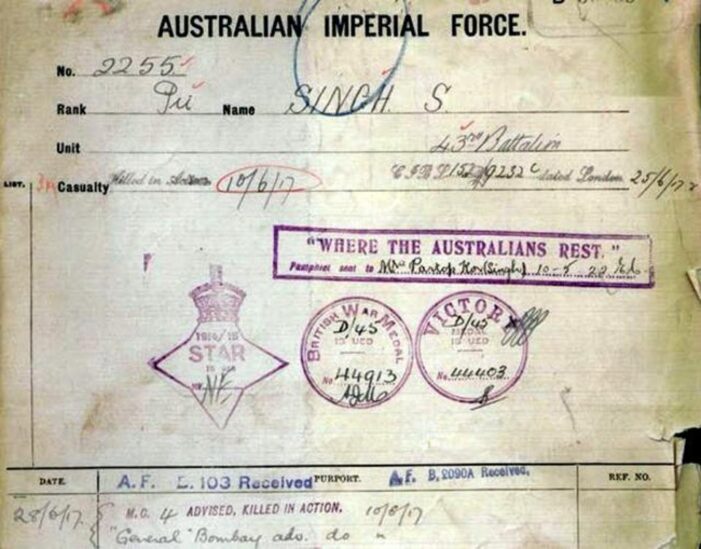Melbourne : On June 16 this year, the governor of South Australia will be hosting a historic reception to mark the death centenary of a decorated Australian soldier, Private Sarn Singh. A member of the Australian Imperial Force, Pte Sarn Singh was killed in action in Belgium on June 10, 1917, while serving in the 43rd Infantry Battalion.
He is one of 19 Sikhs who enlisted in the Australian and New Zealand Army Corps (ANZACs) during World War 1. But, he is the only known casualty in the line of duty. All others returned home to Australia after the war ended, but very little is known about the descendants of most of these pioneering Sikh Australian soldiers
As historian Prof Peter Stanley from University of New South Wales, Canberra, says, ““Sarn Singh, and the ‘Indian-born Anzacs’ who served with him in the Australian Imperial Force, represented a remarkable phenomenon. They were remarkable because they were among the few non-white members of a force that was legally only supposed to include Europeans, an extraordinary exception to the prevailing racist policy of ‘White Australia’.”
Now the Australian Sikh Heritage Association (ASHA) is seeking to find any of Sarn Singh’s living descendants in India, who could possibly attend the landmark commemoration on June 16 in Adelaide, to mark the centenary of his ultimate sacrifice. A ceremony of this kind has never taken place in Australia ever before.
Records say a lot
Pte Sarn Singh’s military records reveal quite a lot about his background. He belonged to village Chhokran, and his postal address was “Post office Moron (possibly Moran), tehsil Phillaur, district Jullundur (now Jalandhar).” His father’s name was Kishan Singh Zaildar (also named as Mayor Kishan Singh in some records), his brother’s name was Charan Singh (who lived in Jandiala) and his wife’s name was Partap Kaur.
There are records of Partap Kaur’s thumb impression on a delivery slip dated June 12, 1922, where she acknowledged receiving the British War Medal and the Victory Medal that were awarded posthumously to her husband Sarn Singh. In fact, she was in touch with Australian authorities repeatedly, desperately seeking a pension after the death of her husband, to alleviate “the pitiable condition” she was living in India. She states, “My father in law and the real brother of my husband are no more ready to support me for my lifetime and it would have been much better if I might have died before my husband.” Although the communication to and from Partap Kaur is recorded for posterity by the National Archives of Australia, it is unclear if she actually went on to receive any pension from the AIF.
Harjit Singh from ASHA says, “Although all of Australia will be marking this day with great fervour, one family deserves to be there much more than any other the family of Sarn Singh who never saw their great-grandfather return home after fighting a war for Australia, in some faraway land. If anyone knows of any descendant of Sarn Singh, please let us know immediately, because we’d like them to attend the commemoration in Adelaide. The family must know that all of Australia salutes Sarn Singh’s valour.”
What will says
In his will, Sarn Singh had appointed Amon Bux (of Waikerie, SA) as the executor, who was asked to remit any savings to his brother Charan Singh (of Jandiala, Punjab), in case he died in war. After being informed of his son’s death in the line of duty, father Kishan Singh wrote a letter in September 1917 asking, “I beg you to be good enough and inform me the details, whether he died of wounds in any hospital , or was killed in the front and whether or not his body was found,” going on to query about any monies that may be owing to the family. AIF records reveal that Sarn Singh’s body was buried by G Huthnance on August 13, 1917, two months after he was killed.
Slight build, tall valour
Military records indicate that Sarn Singh was a man of slight build – he was 5 ft 3 inches tall, weighed 136 lbs and his chest measured up to 34.36 inches. He joined the Australian Imperial Force on May 15, 1916, at Waikerie (SA), declaring he was 33 years old at the time, was a farmer by profession and was born in Jullundur (Jalandhar), India.
He sailed from Adelaide on August 12, 1916, on board the ship Ballarat, landing in Devonport (England) a month and a half later. He served in France for a few months and was then deployed to Belgium, where he was killed on the battlefield in Messines, after completing one year of active service for the Australian Imperial Force.
His name is included in the list of fallen soldiers, inscribed on a special collective cross at the Messines Ridge British cemetery in Belgium. As Stanley says, ““Sarn Singh is now commemorated equally in death alongside his overwhelmingly white comrades on memorials in Belgium, in South Australia and in Canberra.”


You must be logged in to post a comment Login